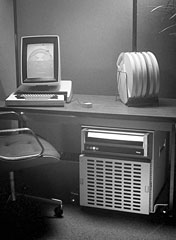 A friend from waaaay back, Scott Warren, just released an iPhone App that's super-loosely based on an idea I programmed back in the 70s (boy I feel old) on the Xerox Alto. The Alto from PARC (Palo Alto Research Center) was the first "personal" computer that paved the way for many products that followed.
A friend from waaaay back, Scott Warren, just released an iPhone App that's super-loosely based on an idea I programmed back in the 70s (boy I feel old) on the Xerox Alto. The Alto from PARC (Palo Alto Research Center) was the first "personal" computer that paved the way for many products that followed.The basic gag of the Dali Clock is morphing numbers as the seconds tick off. This is nothing by today's CGI standards, but back then I had to write the inner loop in microcode for the 74481 chip (All you script kiddies are going to have to look that one up).
When I joined Apple, I realized the 68K processor could manage the problem in assembly language (a step up) so I coded it soon after joining. It was included on the Through the Looking Glass disk (the predecessor of AliceX). Over the years people have ported the idea to unix, Palm, etc. and it has a quite a bit of history out there.
After Scott told me about his program today, I searched iTunes and discovered Scott has the second program based on this golden oldie. Burt Sloane, a guy who worked @ Apple in 1985, has also written one. Burt was famous for writing a Mac version of MazeWars (another Alto original and the first networked Mac game), and a "bug INIT", which littered your screen with crawling bugs.
Scott is famous for implementing SmallTalk outside of Xerox and for writing major portions of Visi-on, an early GUI for DOS machines. Both were technical tour-de-forces, but way ahead of their time in terms of market viability and technical feasibility. Scott also was ahead of the pack and registered his domain, Rosetta.com, back in 1987, one of the first 100 domains ever registered. At that time, most people inside the industry had never used nor heard of email, much less DNS, or HTTP or all the things we now use daily.
Scott's is a more artistic take on the idea whereas Burt's sticks closer to the original script. Both are available on iTunes if you click their names above.
BTW, the 3rd part of the original disk can be found here -- have patience, it's building a big image file.

No comments:
Post a Comment